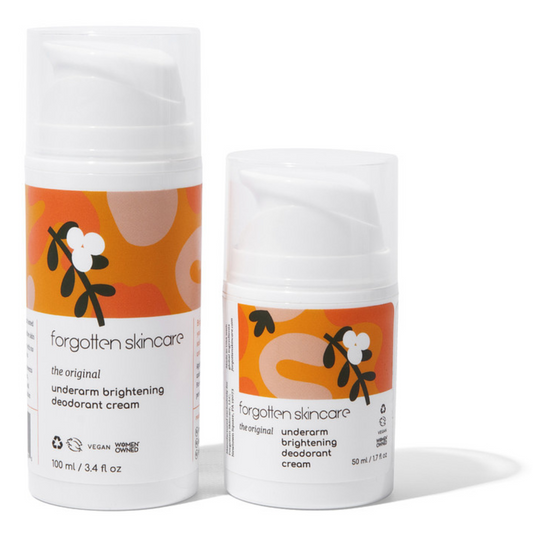
How To Lighten Hidradenitis Suppurativa Scars At Home
If you have ever suffered from hidradenitis suppurativa, then you’re probably familiar with the painful, swollen bumps it can cause. Sometimes known as “acne inversa”, this uncomfortable inflammatory condition can flare up in the armpits, groin or buttocks.
And while an active flare up should be treated by a doctor, the scars left behind can cause just as much disruption to your life and confidence. If you’re dealing with discoloration, hyperpigmentation or scars left from hidradenitis suppurativa, the first step to finding a solution is in understanding the condition.
What is Hidradenitis Suppurativa?
Hidradenitis suppurutiva (HS) is a chronic skin condition that causes painful acne-like nodules and abscesses under the surface of the skin. It can affect any area of the body where hair grows and flare ups are often linked to hormonal fluctuations such as during menstruation or pregnancy. For many, HS can go incorrectly diagnosed for years, often being mistaken for acne, ingrown hair or infection.
HS lesions usually appear on high-friction areas of the body (such as the groin or under the arms), so flare ups can be incredibly uncomfortable. The pus-filled cysts are also prone to breaking open, making the area high-risk for infection, scarring and further complications. Because of this, medical guidance is crucial in helping to prevent and manage any flare ups. Treatments for an active flare up are varied and include topical or oral antibiotics, steroid injections, hormone therapy or oral retinoids. If you suspect that you’re experiencing hidradenitis suppurutiva, it’s worth seeking diagnosis and tailored treatment from a dermatologist to prevent it getting worse.
Unfortunately, the risk of scarring with HS is high. The condition is characterized by lesions that cyclically fill with pus, break open and heal, leaving different types of scars such as keloids, flat scars, tunnels beneath the skin, or pink and brown scars from post-inflammatory hyperpigmentation (PIH). To further complicate the condition, these scars often form on areas that are still experiencing active HS flare ups, making it difficult to target scarring as a primary concern.

Can you get rid of Hidradenitis Suppurativa scars?
So, you’ve been left with scarring from hidradenitis suppurutiva… now what? Once your condition is under control, the good news is that there is a range of treatment options to minimize the look of scars. Ranging from minimally invasive options like topical treatments to surgical intervention, it’s worth talking to a dermatologist to determine the right plan for you and your skin.
Here are some of the most common treatments for the scars left by HS and the types of scars they’re best suited to:
CO2 Laser Resurfacing
Lasers can be beneficial for a range of scarring, and a CO2 laser may be particularly useful on raised keloid or hypertrophic scar tissue. It uses heat to target specific areas and encourage the formation of new collagen, which over time will improve the appearance of these raised scars.
If you have a darker skin tone it’s worth noting that CO2 lasers can come with a higher risk of post-inflammatory hyperpigmentation (PIH). A dermatologist will be able to adjust the laser settings to suit your skin and guide you on the proper post-laser care to prevent hyperpigmentation.
Steroid Injections
Steroid injections, specifically triamcinolone such as the brand Kenalog, can be useful to diminish both keloid scarring and help calm active HS inflammation. This may be a great option for those still dealing with active flare ups, as the steroids can prevent the formation of new scarring and flatten any existing raised keloids. While minimally invasive, steroids are an in office procedure that should be prescribed and injected by your dermatologist.
Brightening Actives
Not everyone who experiences hidradenitis suppurutiva will be left with raised scars, but most will be left with some sort of skin discoloration or hyperpigmentation. Post-inflammatory hyperpigmentation (PIH), or hypermelanosis, is a result of an overproduction of melanin in the skin after inflammation such as an HS flare up. PIH can last for 6 to 12 months or longer, and can lead to feeling uncomfortable in your skin. In fact, up to 80%( of those with HS damage report feelings of psychological effects such as embarrassment or self-consciousness.
A non-invasive, at home way to help lighten and fade scarring is by using targeted, topical active ingredients. Chemical exfoliant ingredients such as glycolic acid, lactic acid or fruit enzymes work to slowly slough off the pigmented skin cells, revealing bright, clear skin over time.
Effective products for Hidradenitis Suppurutiva scars
As HS usually flares up in sensitive areas such as the underarms or groin, it’s important to choose products that are safe for intimate use. Forgotten Skincare has created a vegan, targeted range of products for these areas that need some extra TLC.
In The Shower
To start, the Get It Bright Exfoliating Body Scrub will help you start to brighten scars while in the shower. With balanced exfoliating formula containing Glycolic Acid, Willow Bark Extract and Pumice, this gentle formula can be used a few times a week to smooth and brighten. Simply massage it into wet skin in the shower, rinse off and follow with a soothing moisturizer or targeted treatment
Brighten Underarms
For dark underarms, chemical exfoliation is key. The Original Underarm Brightening Deodorant Cream can help to improve the appearance of PIH day after day. Containing salicylic acid to inhibit bacteria growth and brightening ingredients such as vitamin C and grapefruit oil, this deodorant cream will keep your skin feeling fresh and bright. It’s safe for sensitive skin, making sure to avoid any further inflammation on your already sensitive underarms.
Lighten Inner Thighs
If you’ve had a HS flare up around your groin, you’re probably wondering how to lighten inner thighs. In this sensitive area, it’s important to use products that are both brightening and soothing. The Down Low Inner Thigh Serum contains a combination of Papaya Fruit Enzyme, Licorice Root and Niacinamide to naturally brighten and soothe your intimate areas, leaving you feeling more confident in your skin. Simply apply 1-2 drops affected areas morning and evening, and you can expect to start seeing results within 8-12 weeks.
Your Journey To Bright, Clear Skin
Hidradenitis suppurativa is a painful and frustrating skin condition that can knock anyone’s confidence in their skin. While active inflammation should always be managed by a dermatologist, the scarring left behind from HS can cause just as much mental discomfort over time.
For a gentle, effective solution to scarring and hyperpigmentation at home, Forgotten Skincare has created a range of vegan formulas to help brighten and soothe your skin post-inflammation. Used alone or as a supplement to in-office solutions, Forgotten Skincare is there to help you on your journey to bright, clear skin.
Disclaimer: This information is not meant to treat or diagnose any medical condition. For concerns about whether you have HS, please consult with your doctor. Forgotten Skincare products do not treat HS or any medical condition. The information in this article was compiled by content writers and based on publicly available research.
1. Kirby, Joslyn S. “Qualitative study shows disease damage matters to patients with hidradenitis suppurativa.” Journal of the American Academy of Dermatology vol. 74,6 (2016): 1269-70. doi:10.1016/j.jaad.2016.01.001







